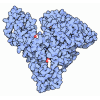Entry Database : PDB / ID : 5ec9Title Retinoic acid receptor alpha in complex with chiral dihydrobenzofuran benzoic acid 9a and a fragment of the coactivator TIF2 LYS-HIS-LYS-ILE-LEU-HIS-ARG-LEU-LEU-GLN-ASP Retinoic acid receptor RXR-alpha Keywords / / Function / homology Function Domain/homology Component
/ / / / / / / / / / / / / / / / / / / / / / / / / / / / / / / / / / / / / / / / / / / / / / / / / / / / / / / / / / / / / / / / / / / / / / / / / / / / / / / / / / / / / / / / / / / / / / / / / / / / / / / / / / / / / / / / / / / / / / / / / / / / / / / / / / / / / / / / / / / / / / / / / / / / / / / / / / / / / / / / / Biological species Homo sapiens (human)Method / Resolution : 2.3 Å Authors Leysen, S. / Ottmann, C. / Schafer, A. / Scheepstra, M. / Brunsveld, L. / Sunden, R. / Ma, J.N. / Burnstein, E.S. / Olsson, R. Funding support Organization Grant number Country Michael J. Fox Foundation Netherlands Organisation for Scientific Research 024.00.035 ECHO 711011017 Marie Curie Action
Journal : J.Med.Chem. / Year : 2016Title : Chiral Dihydrobenzofuran Acids Show Potent Retinoid X Receptor-Nuclear Receptor Related 1 Protein Dimer Activation.Authors : Sunden, H. / Schafer, A. / Scheepstra, M. / Leysen, S. / Malo, M. / Ma, J.N. / Burstein, E.S. / Ottmann, C. / Brunsveld, L. / Olsson, R. History Deposition Oct 20, 2015 Deposition site / Processing site Revision 1.0 Mar 9, 2016 Provider / Type Revision 1.1 Sep 13, 2017 Group / Data collection / Category / pdbx_audit_supportItem / _pdbx_audit_support.funding_organizationRevision 2.0 Aug 10, 2022 Group / Database references / Derived calculationsCategory atom_site / database_2 ... atom_site / database_2 / pdbx_struct_assembly / pdbx_struct_assembly_gen / pdbx_struct_assembly_prop / pdbx_struct_oper_list Item _atom_site.occupancy / _database_2.pdbx_DOI ... _atom_site.occupancy / _database_2.pdbx_DOI / _database_2.pdbx_database_accession / _pdbx_struct_assembly.details / _pdbx_struct_assembly.method_details / _pdbx_struct_assembly.oligomeric_count / _pdbx_struct_assembly.oligomeric_details Revision 2.1 Jun 19, 2024 Group / Category / chem_comp_bond
Show all Show less
 Yorodumi
Yorodumi Open data
Open data Basic information
Basic information Components
Components Keywords
Keywords Function and homology information
Function and homology information Homo sapiens (human)
Homo sapiens (human) X-RAY DIFFRACTION / Resolution: 2.3 Å
X-RAY DIFFRACTION / Resolution: 2.3 Å  Authors
Authors United States,
United States,  Netherlands, 4items
Netherlands, 4items  Citation
Citation Journal: J.Med.Chem. / Year: 2016
Journal: J.Med.Chem. / Year: 2016 Structure visualization
Structure visualization Molmil
Molmil Jmol/JSmol
Jmol/JSmol Downloads & links
Downloads & links Download
Download 5ec9.cif.gz
5ec9.cif.gz PDBx/mmCIF format
PDBx/mmCIF format pdb5ec9.ent.gz
pdb5ec9.ent.gz PDB format
PDB format 5ec9.json.gz
5ec9.json.gz PDBx/mmJSON format
PDBx/mmJSON format Other downloads
Other downloads 5ec9_validation.pdf.gz
5ec9_validation.pdf.gz wwPDB validaton report
wwPDB validaton report 5ec9_full_validation.pdf.gz
5ec9_full_validation.pdf.gz 5ec9_validation.xml.gz
5ec9_validation.xml.gz 5ec9_validation.cif.gz
5ec9_validation.cif.gz https://data.pdbj.org/pub/pdb/validation_reports/ec/5ec9
https://data.pdbj.org/pub/pdb/validation_reports/ec/5ec9 ftp://data.pdbj.org/pub/pdb/validation_reports/ec/5ec9
ftp://data.pdbj.org/pub/pdb/validation_reports/ec/5ec9 F&H Search
F&H Search Links
Links Assembly
Assembly

 Components
Components Homo sapiens (human) / Gene: RXRA, NR2B1 / Production host:
Homo sapiens (human) / Gene: RXRA, NR2B1 / Production host: 
 Homo sapiens (human) / References: UniProt: Q15596*PLUS
Homo sapiens (human) / References: UniProt: Q15596*PLUS X-RAY DIFFRACTION
X-RAY DIFFRACTION Sample preparation
Sample preparation ROTATING ANODE / Type: RIGAKU MICROMAX-003 / Wavelength: 1.5 Å
ROTATING ANODE / Type: RIGAKU MICROMAX-003 / Wavelength: 1.5 Å Processing
Processing Movie
Movie Controller
Controller


 PDBj
PDBj













